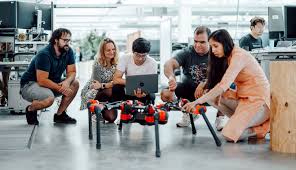Source: analyticsinsight.net
Have you heard of the term Roboticized Economy? That is what every country aspires to become through the fourth industrial revolution. On one hand, America and China like powerful nations are moving towards gaining AI (Artificial Intelligence) Supremacy, many countries across the globe are adopting robotics enabled culture at a wide scale. And COVID-19 pandemic has provided an edge to its extensive applications. Subsequently, owing to the rising popularity of machines and software, several governments are investing a hefty sum into their research and development work.
According to a recent research study presented by the International Federation of Robotics, various governments are funding research programmes. Professor Jong-Oh Park, vice-chair of the International Federation of Robotics (IFR) Research Committee and member of the Executive Board said, “Each country has its own characteristics of robot programmes based on its specific background and history… Therefore, we see that robotics programmes set up by the most advanced robotics countries have a very different strategic focus.
As noted by the Manufacturer, here are some of the government-driven robotics R&D programmes
China
The strategic plan Made in China 2025 serves as a blueprint to upgrade the manufacturing capabilities of Chinese industries. This includes an investment of advanced robots among the top 10 core industries.
The Robot Industry Development Plan sets out the goals for China in 2020, including:
• developing three to five globally competitive robot manufacturers,
• creating eight to 10 industrial clusters,
• achieving 45% of domestic market share for China’s high-end robots,
• increasing China’s robot density to 100 robots per 10,000 workers.
• China reached a robot density of 140 units per 10,000 workers in the manufacturing industry in 2018, according to IFR data.
Furthermore, in 2019, the Chinese government invested US$577 million in the development of intelligent robots.
Japan
The New Robot Strategy in Japan is a key policy of the Abenomics Growth Strategy. The robot-related budget for 2019 has been increased to US$351 million, with the aim to make Japan the robot innovation hub in the world.
The action plan includes manufacturing as well as important service sectors like healthcare, agriculture, and infrastructure.
According to IFR’s data, Japan is the world´s number one industrial robot manufacturer and delivered 52% of the global supply in 2018.
South Korea
The Intelligent Robot Development and Supply Promotion Act of Korea is pushing to develop the robot industry in Korea as a core industry in its Fourth Industrial Revolution.
The third basic plan for Intelligent Robots published in 2019 promotes systematic selection and concentration of promising public and private sectors.
Focus areas include manufacturing businesses, selected service robot areas (including healthcare and logistics), next-generation key components, and key robot software.
The robot-related budget for 2020 is US$126 million (₩ 151bn).
IFR data shows a new record stock of circa 300,000 operational industrial robots in the Republic of Korea in 2018 (+10%). In five years, the country has doubled its number of industrial robots in operation. Following Japan and China, the country ranked third in 2018.
Europe
Robotics projects funded by Horizon 2020, the European Union´s eighth Framework Programme, represent a wide variety of research and innovation topics – ranging from manufacturing, commercial, and healthcare use to consumer, transportation, and agri-food robotics.
Through this programme, the European Commission provides an estimated US$780 million in funding for robotics research and innovation over its seven-year runtime.
The main topics of the Work Program 2018-2020 are related to digitization of industry through robotics, robotics applications in promising new areas, and robotics core technologies such as AI and cognition, cognitive mechatronics, socially cooperative human-robot interaction, and model-based design and configuration tools, with the total budget of US$173 million.
Germany
As part of its High-Tech Strategy, Germany supports the use of new digital technologies within industry and administration.
The PAiCE programme with a funding budget of US$55 million (€50m) over five years emphasizes the development of digital industry platforms as well as collaboration between companies using these platforms.
In particular, the robotics-oriented projects are focusing on the creation of platforms for service robotics solutions in the various relevant application areas including service, logistics, and manufacturing fields.
Germany is the fifth largest robot market in the world and number one in Europe, followed by Italy and France. In 2018, the number of robots sold increased by 26% to almost 27,000 units – a new all-time record.
America
The National Robotics Initiative (NRI) in the US was launched for fundamental robotics R&D supported by the US government.
The main goals focus on fundamental science, technologies, and integrated systems needed to achieve a vision of ubiquitous collaborative robots assisting humans in every aspect of life.
Moreover, in NRI-2.0, the collaboration between academia, industry, non-profit, and other organizations is encouraged. The budget of NRI for 2019 was US$35 million.
Additional robotics funding for application in defense and space is provided through the Department of Defense (DoD) and the Mars Exploration Program.
According to IFR data, robot installations in the US increased for the eighth year in a row to a new peak in 2018. Regarding annual installations, the country has taken the third position from South Korea.


